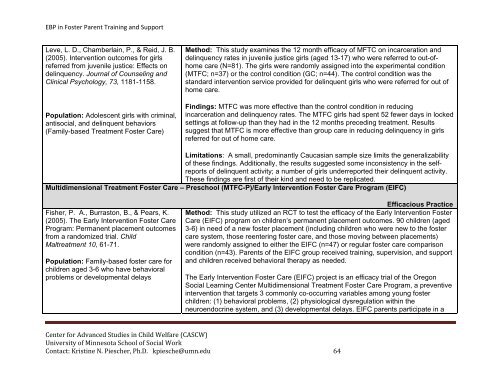Evidence-Based Practice in Foster Parent Training and Support ...
Evidence-Based Practice in Foster Parent Training and Support ...
Evidence-Based Practice in Foster Parent Training and Support ...
You also want an ePaper? Increase the reach of your titles
YUMPU automatically turns print PDFs into web optimized ePapers that Google loves.
EBP <strong>in</strong> <strong>Foster</strong> <strong>Parent</strong> Tra<strong>in</strong><strong>in</strong>g <strong>and</strong> <strong>Support</strong>Leve, L. D., Chamberla<strong>in</strong>, P., & Reid, J. B.(2005). Intervention outcomes for girlsreferred from juvenile justice: Effects ondel<strong>in</strong>quency. Journal of Counsel<strong>in</strong>g <strong>and</strong>Cl<strong>in</strong>ical Psychology, 73, 1181-1158.Population: Adolescent girls with crim<strong>in</strong>al,antisocial, <strong>and</strong> del<strong>in</strong>quent behaviors(Family-based Treatment <strong>Foster</strong> Care)Method: This study exam<strong>in</strong>es the 12 month efficacy of MFTC on <strong>in</strong>carceration <strong>and</strong>del<strong>in</strong>quency rates <strong>in</strong> juvenile justice girls (aged 13-17) who were referred to out-ofhomecare (N=81). The girls were r<strong>and</strong>omly assigned <strong>in</strong>to the experimental condition(MTFC; n=37) or the control condition (GC; n=44). The control condition was thest<strong>and</strong>ard <strong>in</strong>tervention service provided for del<strong>in</strong>quent girls who were referred for out ofhome care.F<strong>in</strong>d<strong>in</strong>gs: MTFC was more effective than the control condition <strong>in</strong> reduc<strong>in</strong>g<strong>in</strong>carceration <strong>and</strong> del<strong>in</strong>quency rates. The MTFC girls had spent 52 fewer days <strong>in</strong> lockedsett<strong>in</strong>gs at follow-up than they had <strong>in</strong> the 12 months preced<strong>in</strong>g treatment. Resultssuggest that MTFC is more effective than group care <strong>in</strong> reduc<strong>in</strong>g del<strong>in</strong>quency <strong>in</strong> girlsreferred for out of home care.Limitations: A small, predom<strong>in</strong>antly Caucasian sample size limits the generalizabilityof these f<strong>in</strong>d<strong>in</strong>gs. Additionally, the results suggested some <strong>in</strong>consistency <strong>in</strong> the selfreportsof del<strong>in</strong>quent activity; a number of girls underreported their del<strong>in</strong>quent activity.These f<strong>in</strong>d<strong>in</strong>gs are first of their k<strong>in</strong>d <strong>and</strong> need to be replicated.Multidimensional Treatment <strong>Foster</strong> Care – Preschool (MTFC-P)/Early Intervention <strong>Foster</strong> Care Program (EIFC)Fisher, P. A., Burraston, B., & Pears, K.(2005). The Early Intervention <strong>Foster</strong> CareProgram: Permanent placement outcomesfrom a r<strong>and</strong>omized trial. ChildMaltreatment 10, 61-71.Population: Family-based foster care forchildren aged 3-6 who have behavioralproblems or developmental delaysEfficacious <strong>Practice</strong>Method: This study utilized an RCT to test the efficacy of the Early Intervention <strong>Foster</strong>Care (EIFC) program on children’s permanent placement outcomes. 90 children (aged3-6) <strong>in</strong> need of a new foster placement (<strong>in</strong>clud<strong>in</strong>g children who were new to the fostercare system, those reenter<strong>in</strong>g foster care, <strong>and</strong> those mov<strong>in</strong>g between placements)were r<strong>and</strong>omly assigned to either the EIFC (n=47) or regular foster care comparisoncondition (n=43). <strong>Parent</strong>s of the EIFC group received tra<strong>in</strong><strong>in</strong>g, supervision, <strong>and</strong> support<strong>and</strong> children received behavioral therapy as needed.The Early Intervention <strong>Foster</strong> Care (EIFC) project is an efficacy trial of the OregonSocial Learn<strong>in</strong>g Center Multidimensional Treatment <strong>Foster</strong> Care Program, a preventive<strong>in</strong>tervention that targets 3 commonly co-occurr<strong>in</strong>g variables among young fosterchildren: (1) behavioral problems, (2) physiological dysregulation with<strong>in</strong> theneuroendocr<strong>in</strong>e system, <strong>and</strong> (3) developmental delays. EIFC parents participate <strong>in</strong> aCenter for Advanced Studies <strong>in</strong> Child Welfare (CASCW)University of M<strong>in</strong>nesota School of Social WorkContact: Krist<strong>in</strong>e N. Piescher, Ph.D. kpiesche@umn.edu 64
















